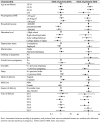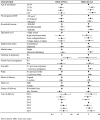Demographic risk factors for adverse birth outcomes in Puerto Rico in the PROTECT cohort
- PMID: 31194765
- PMCID: PMC6564423
- DOI: 10.1371/journal.pone.0217770
Demographic risk factors for adverse birth outcomes in Puerto Rico in the PROTECT cohort
Abstract
Preterm birth is a major public health problem, especially in Puerto Rico where the rates are among the highest observed worldwide, reaching 18% in 2011. The Puerto Rico Testsite for Exploring Contamination Threats (PROTECT) study is an ongoing investigation of environmental factors that contribute to this condition. In the present analysis, we sought to examine common risk factors for preterm birth and other adverse birth outcomes which have not been characterized previously in this unique population. Pregnant women from the PROTECT cohort are recruited from the heavily contaminated Northern coast of the island of Puerto Rico and are free of pre-existing conditions like diabetes. We examined associations between basic demographic, behavioral (e.g., tobacco and alcohol use), and pregnancy (e.g., season and year of delivery) characteristics as well as municipality of residence in relation to preterm birth (<37 weeks gestation), postterm birth (≥41 weeks gestation), and small and large for gestational age in univariate and multivariate logistic regression models. Between 2011 and 2017, 1028 live singleton births were delivered as part of the PROTECT cohort. Of these, 107 (10%) were preterm. Preterm birth rates were higher among women with low socioeconomic status, as indicated by education level and income, and among women with high pre-pregnancy body mass index (BMI). Odds ratios of small for gestational age delivery were higher for women who reported tobacco use in pregnancy and lower for women who delivered in the hurricane and dengue season (July-October). Overall, in pregnant women residing in Puerto Rico, socioeconomic status was associated with preterm birth but few other factors were associated with this or other adverse outcomes of pregnancy. Research to understand environmental factors that could be contributing to the preterm birth epidemic in Puerto Rico is necessary.
Conflict of interest statement
The authors have declared that no competing interests exist.
Figures



Similar articles
-
Assisted Reproductive Technology Surveillance - United States, 2018.MMWR Surveill Summ. 2022 Feb 18;71(4):1-19. doi: 10.15585/mmwr.ss7104a1. MMWR Surveill Summ. 2022. PMID: 35176012 Free PMC article.
-
Assisted reproductive technology surveillance--United States, 2011.MMWR Surveill Summ. 2014 Nov 21;63(10):1-28. MMWR Surveill Summ. 2014. PMID: 25412164
-
Assisted Reproductive Technology Surveillance — United States, 2012.MMWR Surveill Summ. 2015 Aug 14;64(6):1-29. MMWR Surveill Summ. 2015. PMID: 26270152
-
Preterm birth and PM2.5 in Puerto Rico: evidence from the PROTECT birth cohort.Environ Health. 2021 Jun 11;20(1):69. doi: 10.1186/s12940-021-00748-5. Environ Health. 2021. PMID: 34116688 Free PMC article.
-
Critical Overview of Current Drug Abuse in Puerto Rico based on Governmental Data.P R Health Sci J. 2024 Dec;43(4):177-185. P R Health Sci J. 2024. PMID: 39671410 Review.
Cited by
-
Examining the association between prenatal maternal stress and infant non-nutritive suck.Pediatr Res. 2023 Apr;93(5):1285-1293. doi: 10.1038/s41390-021-01894-9. Epub 2021 Dec 16. Pediatr Res. 2023. PMID: 34916626 Free PMC article.
-
Associations between social, biologic, and behavioral factors and biomarkers of oxidative stress during pregnancy: Findings from four ECHO cohorts.Sci Total Environ. 2022 Aug 20;835:155596. doi: 10.1016/j.scitotenv.2022.155596. Epub 2022 Apr 29. Sci Total Environ. 2022. PMID: 35490822 Free PMC article.
-
Environmental phthalate exposure and preterm birth in the PROTECT birth cohort.Environ Int. 2019 Nov;132:105099. doi: 10.1016/j.envint.2019.105099. Epub 2019 Aug 17. Environ Int. 2019. PMID: 31430608 Free PMC article.
-
Repeated measures of urinary oxidative stress biomarkers and preterm birth in Puerto Rico.Free Radic Biol Med. 2020 Jan;146:299-305. doi: 10.1016/j.freeradbiomed.2019.11.003. Epub 2019 Nov 5. Free Radic Biol Med. 2020. PMID: 31704372 Free PMC article.
-
Associations between socioeconomic status, psychosocial stress, and urinary levels of 8-iso-prostaglandin-F2α during pregnancy in Puerto Rico.Free Radic Biol Med. 2019 Nov 1;143:95-100. doi: 10.1016/j.freeradbiomed.2019.07.032. Epub 2019 Jul 29. Free Radic Biol Med. 2019. PMID: 31369838 Free PMC article.
References
-
- Butler AS, Behrman RE. Preterm birth: causes, consequences, and prevention: National Academies Press; 2007. - PubMed
-
- March of Dimes. March of Dimes 2011 premature birth report card 2011. http://media.graytvinc.com/documents/usmap.pdf.
-
- March of Dimes. The global action report on preterm birth 2012. https://www.marchofdimes.org/mission/global-preterm.aspx#tabs-1.
-
- March of Dimes. March of Dimes 2017 premature birth report card 2017. https://www.marchofdimes.org/materials/PrematureBirthReportCard-United-S....
Publication types
MeSH terms
Grants and funding
LinkOut - more resources
Full Text Sources

